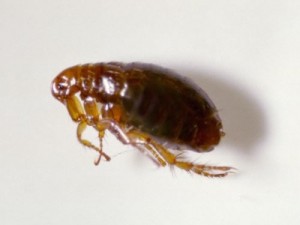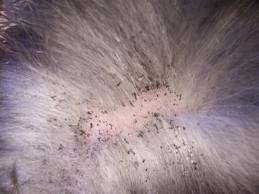About the Flea:
 There are several species of fleas, but the one most commonly affects dogs, cats and other house pets is the dog or cat flea. Fleas are tiny, irritating external parasites. They are wingless with a hard and laterally flat body designed to easily navigate through pet hair. The flea also has 3 pairs of legs, the hindmost pair designed for jumping great distances. They don’t grow much larger than the tip of a pen and range from light brown to almost black in colour. Their mouthparts are adapted for piercing skin and sucking blood and living off the blood of mammals and birds. While this type of flea can bite humans, it does not infest us, as the human is not an ideal host. Their bites are itchy and sometimes painful and getting rid of them without pesticide treatment is almost impossible. They reproduce quickly and even if there is one many often will follow. Flea Allergic Dermatitis or FAD: Itching due to fleas is the result of a localized allergic reaction. Some animals are more sensitive than others, so flea bites can lead to severe itching, irritation, major skin infections in some pets. Tapeworm infection (Dipylidium caninum): This type of tapeworm can be contracted by animals or humans after accidental ingestion of an infected flea. Flea larva often ingest the microscopic tapeworm eggs, causing adult fleas to be carriers.
There are several species of fleas, but the one most commonly affects dogs, cats and other house pets is the dog or cat flea. Fleas are tiny, irritating external parasites. They are wingless with a hard and laterally flat body designed to easily navigate through pet hair. The flea also has 3 pairs of legs, the hindmost pair designed for jumping great distances. They don’t grow much larger than the tip of a pen and range from light brown to almost black in colour. Their mouthparts are adapted for piercing skin and sucking blood and living off the blood of mammals and birds. While this type of flea can bite humans, it does not infest us, as the human is not an ideal host. Their bites are itchy and sometimes painful and getting rid of them without pesticide treatment is almost impossible. They reproduce quickly and even if there is one many often will follow. Flea Allergic Dermatitis or FAD: Itching due to fleas is the result of a localized allergic reaction. Some animals are more sensitive than others, so flea bites can lead to severe itching, irritation, major skin infections in some pets. Tapeworm infection (Dipylidium caninum): This type of tapeworm can be contracted by animals or humans after accidental ingestion of an infected flea. Flea larva often ingest the microscopic tapeworm eggs, causing adult fleas to be carriers.
The Life Cycle of Fleas is comprised of four stages:
Adult: Adult fleas prefer to live on the animal and their diet consists of blood meals courtesy  of the host animal. The female flea lays white, roundish eggs and can lay up to 50 eggs per day, 500-600 eggs over several months.
of the host animal. The female flea lays white, roundish eggs and can lay up to 50 eggs per day, 500-600 eggs over several months.
Egg: The eggs are not sticky (like some parasites), and they usually fall off of the animal into the carpet, bedding, floorboards, and soil. When the flea egg hatches varies — anywhere from two days to a few weeks, depending on environmental conditions. The larva emerges from the egg using a chitin tooth, a hard spine on the top of the head that disappears as the flea matures.
Larva: When the eggs hatch, larvae emerge. These tiny worm-like creatures feed upon flea feces (basically dried animal blood) and other organic debris found in the environment. The larva goes through three developmental stages before it becomes able to spin a cocoon and enter the pupa stage. The larval stage typically lasts from 5 to 15 days depending on the amount of food present and the environmental conditions then the larva spins a silken cocoon and pupates.
Pupa (plural = pupae): The pupa is the last stage before adult. Once in the cocoon, the larva begins its transformation into the adult flea. The cocoons are nearly indestructible and attract dirt and debris that camouflage them. The adult flea can emerge from the cocoon as early as 3 to 5 days, or it can stay in the cocoon for a year or more, waiting for the right time to emerge. When is the right time? Until they sense a host. They are able to do this by sensing factors like warmth, vibration and carbon dioxide from a passing animal. This brings us back to the adult flea.
Adult flea: A fully-developed flea only emerges from its cocoon when a host is available. The newly-emerged flea jumps on the host right away and begins the blood meal. A female flea will begin to lay eggs within 24-48 hours of her first blood meal. She defecates blood from her host that will fall off the host along with the eggs, re-starting the life cycle. Adult fleas can live for about 4-6 weeks depending on the environment.
The entire life cycle is quite variable, as evidenced by the variability in each life stage progression. As mentioned above, the cycle can be as short as two weeks or as long as two years. That is why it is so important to remain vigilant, even when a flea problem is thought to be under control! The flea life cycle is multi-stage and complicated. Giving your pet a flea bath or putting on a flea collar will not solve the problem. Fleas on the pet and in the environment must be addressed in order to control fleas on your pet.
A mistake seen all too often is the “more is better” approach that some people take when using flea products. More is NOT better when it comes to chemicals or medications! Following package directions is essential when using over the counter products and medications. Only buy products that are labeled for use on the species you will be using them on (dog, cat, etc.). Cats in particular are very sensitive to drugs and chemicals – be sure to read all labels carefully. 
Even when labels are read and instructions are followed, adverse reactions to flea product can happen. Call your vet immediately.
Remedies:
- Flea shampoos
A shampoo, or “flea bath” is a good first attack on fleas for the pet that has large numbers of fleas visible on its body. Cats can be difficult to bathe. It is important to realize that a flea shampoo is not intended for lasting control. Many people are surprised when they see fleas and it was “only a week ago” that the pet had a flea bath. Shampoos are only effective for a day or less. They leave little residual chemical on the animal when properly used. - Flea dips
Flea dips are strong chemical rinses to rid animals not only of fleas, but mites and ticks as well. Dips last approximately 1-2 weeks. Flea shampoos and dips are effective for adult fleas. - Flea collars
Flea collars work one of two ways – by emitting a toxic (to fleas, anyway) gas, and by being absorbed into the animal’s subcutaneous fat layer. The toxic gas is usually only effective in the immediate area of the head and neck. This type of collar is best used in the vacuum cleaner bags to kill any fleas vacuumed up. The collars that absorb into the subcutaneous fat are much more effective. Flea collars are effective for adult fleas. - Flea powders and sprays
Flea powders and sprays offer short term (2-3 day) protection from fleas and with some products, ticks and mites too. Powders and sprays have fallen out of favor recently with the newer spot-on treatments that are available. Most flea powders and sprays are only effective for adult fleas, some offer additional flea protection by inhibiting flea egg and larval development. - Topical flea treatments
Common brand names include: Advantage ™, Frontline®, Secureguard® just to name a few. They are distributed in the dog’s natural skin oils and work to kill adult fleas.
These products are applied between the shoulder blades of the pet, and typically last about one month. Spot-on treatments are effective for adult fleas. Some include ingredients to inhibit the larva from emerging from the flea egg and some are active against larval development as well. They are usually water-resistant, meaning you can bathe your dog with a mild shampoo 3 or more days after applying the product. Be aware that not all “spot-on” products are equal. Generally, those sold in grocery stores are ineffective. When it comes to topical flea prevention, you typically get what you pay for.
- Oral medications
Flea “pills”, such as Nexgard® work by stopping the larva from emerging from the flea egg. Fleas ingest the blood of animals on these medications, and the female fleas then lay eggs that are unable to hatch. These medications are essential to break the flea life cycle and stop the flea problem when used in conjunction with flea adulticide treatments.
Natural Flea Prevention
For ages, people have tried to come up with home remedies and natural products to ward off fleas. While natural remedies are useful for a number of issues, generally flea treatment is not one of them. Some say a bit of garlic in the diet helps to prevent flea infestations. In reality, this is not typically affective. In addition, excess garlic in the diet can lead to toxicity for some dogs. Another natural method is the use of essential oils and/or herbs on the pet’s skin and coat. Unfortunately, there is not sufficient documented evidence regarding the effectiveness of this method.
If you choose to go the natural method, just remember three things:

